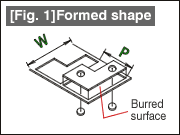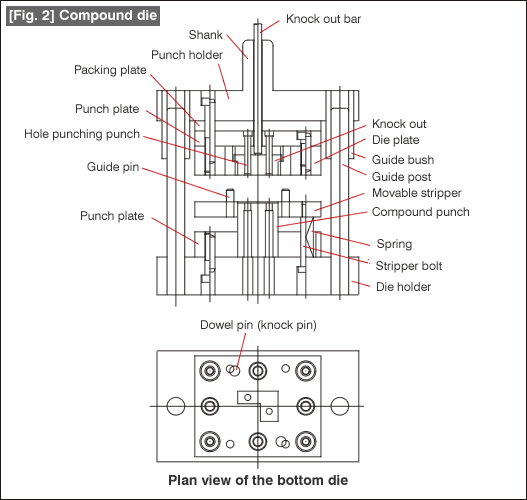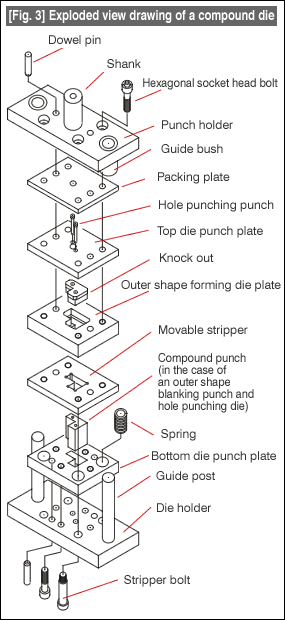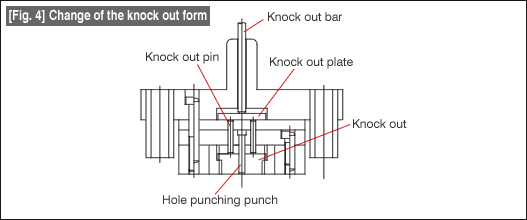HOME > Press Dies Tutorial > #031 Basics of Die Structure (6) Structure of Compound Dies
Press Dies Tutorial
#031 Basics of Die Structure (6) Structure of Compound Dies
Category : Shearing work
March 5, 2010
|
Compound blanking operation is that of carrying out forming outer shape and hole punching simultaneously. This operation is called "compound processing". Furthermore, this type of work is also called "combined processing." As shown in Fig. 1, the forming the outer shape is carried out upwards from below and hole punching is performed downwards from above. This can be said to be a combination of an inverted placement structure outer shape forming die that forms the outer shape and a movable stripper structure die which punches the holes (this has already been discussed in a previous course as a method of preparing compound die structures). |
 |
The basic structure of a compound die is shown in Fig. 2.

The features of compound blanking operation are - (1) It is possible to reduce the number of processing steps; (2) Since the accuracy of the relationship between outer shape and holes is determined by the die, the accuracy of the product becomes better; (3) The flatness is good because the work is done while keeping the material pressed by the knock outs and the punches; (4) The directions of the burrs of holes and outer shape are the same, etc.
|
On the contrary, since the structure becomes complex, there is the drawback that the number of steps of preparing the die becomes large. For the sake of reference, an exploded view drawing of a compound die is shown in Fig. 3. It is obvious that the structure is quite complex. In this figure, the knock out and compound punch are compound parts arising out of combined processing operations. The knock out has the functions of ejecting the product and of a hole punching stripper. The compound punch is a combination of a punch for outer shape blanking and a die for hole punching. These two parts will have almost the same shape as that of the product. Therefore, the die does not function if these tow products become weak and break. In compound blanking, the formed product is discharged into the die in the top die. Very often the method of recovering the discharged product by blowing it out using compressed air (air blowing off) is used. However, this air blowing off cannot be said to be efficient, and can be considered to be a disadvantage of compound blanking. Although the discharge of the product from the die is done by the knock out, because of the hole punching punch it cannot be formed in the mode of Fig. 2, but very often it will have a structure of the form shown in Fig. 4. It can even be said that the form of Fig. 4 is the more standard one. |
 |

- #167 Problems in Punching and their Countermeasures (6) Scrap Processing in Punching
- #166 Problems in Punching and their Countermeasures (5) Trimming of Drawn and Shaped Parts
- #165 Problems in Punching and their Countermeasures (4) Scrap Clogging in Punching
- #164 Problems in Punching and their Countermeasures (3) Bending and Twisting of Narrow Punched Parts
- #163 Problems in Punching and their Countermeasures (2) Bending due to Punching



